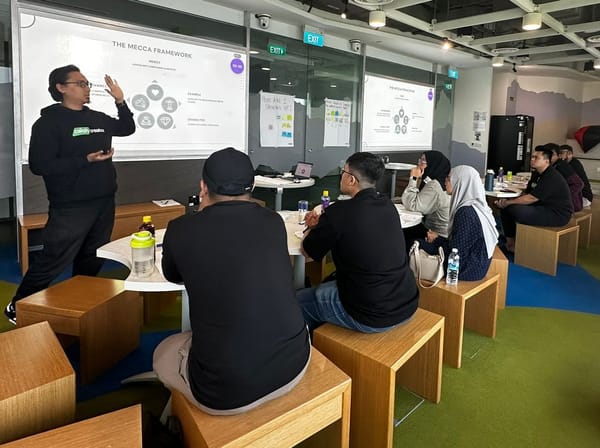Your Business Can't Live On One Social Platform Alone

I keep seeing the same pattern.
Someone hits 3 million views on TikTok.
Zero sales from it.
They built an audience. Not a business.
It's great when one channel is working well. When it's growing rapidly. When the algorithm loves you.
But here's the question: Does it actually work for your business?
And more importantly: What happens when it stops?
The High-Risk Model
Sure, you can build a business on one platform.
Some people do. They go all-in on TikTok. Or Instagram. Or LinkedIn.
It works... until it doesn't.
Algorithm changes. Shadowban hits. Platform priorities shift.
One change and their entire income is at risk.
Millions of followers. But no buyers.
High growth. High risk.
This isn't marketing. It's gambling.
What Actually Works: The Marketing Ecosystem
You don't need another viral post.
You need a complete system where every component works together.
Not platform-specific. Platform-independent.
Here are the 5 components you need.
This is what I use. What my clients use. What gets results.
Let me show you how to build them...
Component 1: Your Offer
Before anything else, get crystal clear on what you're selling.
Write it down in one sentence.
Bad example: "I help people with marketing"
Good example: "I write email campaigns that generate $25K-$50K for coaching businesses"
Then ask yourself: Who specifically needs this? What problem keeps them up at night? What result do they want?
Put this in your bio. Mention it in your content.
Start here: If a stranger looks at your profile right now, can they tell what you offer? If not, fix this first.
When I started, I just had a LinkedIn profile and a Google Doc. That's it.
Simple offer. Clear on the profile. Google Doc with examples and pricing.
No fancy website.
Component 2: Lead Generation (Pick One Channel First)
You never want to depend on one platform eventually.
But when you're starting? Pick ONE channel and master it.
Option A: Outbound prospecting
Make a list of 20 ideal clients you want to work with.
Find them on LinkedIn or Instagram. Get their contact info.
Reach out. Personalize the first line. State what you do clearly. Ask one question to start a conversation.
Do 5 per day. That's 25 per week.
Option B: Inbound content
Choose ONE platform. Where does your buyer actually spend time?
Post consistently. A few times per week if daily feels like too much. The key is consistency, not frequency.
Every post should drive conversations.
Include your offer in your posts occasionally. End with a clear call to action: "DM me if you want help with X"
What should you post? Case studies. Client pain points. Quick wins. Behind-the-scenes.
I started with just LinkedIn. Got clients from there.
Then added Facebook.
Then email list.
Then a bit of Instagram.
And a tiny presence on YouTube and Tiktok for video stuff.
Then now Linkedin Sales Navigator.
Then Facebook Ads.
Offline meetups. Networking.
And so on.
But pick one. Master it. Then add a second channel later.
Component 3: Own Your Audience
Your email list is the only audience you truly own.
Platform dies? Your list doesn't.
Create a simple lead magnet. Something people can implement in 10-30 minutes.
Could be a checklist. A template. A resource list.
Set up email capture using an email service provider (I'm using ActiveCampaign and Ghost, but it's entirely up to you).
Build a simple landing page.
Keep the form simple: name and email only.
Promote it in your bio and in conversations.
Email your list once a week. Share insights. Tell stories. Make offers.
Component 4: Turn Conversations Into Clients
This is where money happens.
When someone enquires, qualify them first.
What's their current situation? What result do they want? What's their budget range?
Sometimes you'll jump on a call. Sometimes you won't need to.
I often just share a Google Doc with the details and people buy. No call needed.
If you do get on a call, keep it simple:
- First 5 minutes: Understand their problem.
- Next 5 minutes: Explain how you solve it.
- Last 5 minutes: Present your offer and next steps.
Follow up same day.
Send your proposal (Google Doc, PDF, whatever works).
Include payment link. Set deadline: 48-72 hours.
Track: Conversations → Proposals sent → Clients.
Component 5: Measure What Matters
Stop measuring followers and likes.
Start measuring: How many enquiries this week? How many proposals sent? How many became clients?
Write it down every week.
What's working? Do more of that.
What's not? Fix it or cut it.
Start With Just One Component
You don't need all 5 components running perfectly right now.
Start with ONE this week.
If you have no clarity:
Start with Component 1: Fix your offer. Make it crystal clear.
If you have clarity but no leads:
Start with Component 2: Pick ONE channel. Outbound or inbound. Stay consistent.
If you have leads but losing them:
Start with Component 3. Build your email list. Own your audience.
If you have conversations but not closing:
Start with Component 4. Document your sales process. Create your proposal doc.
If you're doing all this but don't know what's working:
Start with Component 5. Track your numbers weekly.
One component at a time. Master it. Then add the next.
That's how you build a marketing system that doesn't collapse when platforms change.
The 5-Step System (Quick Reference)
Step 1: Clarify Your Offer
- Write what you sell in one sentence
- Put it in your bio
- Create a simple Google Doc with examples and pricing
Step 2: Pick One Lead Channel
- Outbound: 5 personalized messages per day
- OR Inbound: Post consistently on one platform (a few times per week)
- Master one channel before adding another
Step 3: Build Your Email List
- Create a simple lead magnet (checklist, template, resource)
- Set up email capture (ConvertKit, Mailchimp, ActiveCampaign)
- Email once a week
Step 4: Convert Conversations
- Qualify enquiries (situation, result wanted, budget)
- Share Google Doc with offer OR jump on 15-min call
- Have 2-3 packages ready
- Follow up same day with proposal and payment link
Step 5: Track What Matters
- Weekly: Count enquiries, proposals sent, clients closed
- What's working? Do more.
- What's not? Fix or cut.
The Difference
Most people post content and hope something happens.
They chase followers. They depend on one platform. They have no idea what's working.
System thinkers build deliberately. One component at a time. They track what matters. They own their audience. They survive platform changes.
This is an easy 5-step process.
I use it. My clients use it to get results.
What about you?
Are you building a platform-dependent business... or a marketing ecosystem?
— Rusydi
P.S. If you need help building your marketing system, reply with "SYSTEM" at this link and let's talk. I'll walk you through exactly where to start based on where you are right now.




